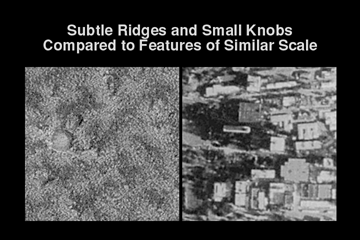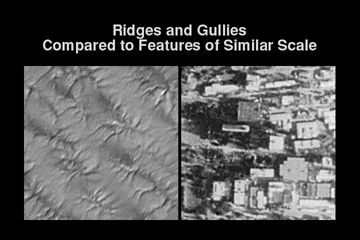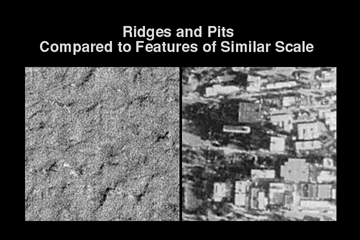
Mars Global Surveyor
Mars Orbiter Camera
Mars Polar Lander Landing Zone Compared With JPL
MGS MOC Release No. MOC2-192, 2 December 1999
What will Mars Polar Lander find when it reaches the red planet
on December 3, 1999? The Mars Global Surveyor (MGS) Mars Orbiter
Camera (MOC)--currently operating in Mars orbit since September
1997--is providing some of our highest-resolution views of
the planet ever obtained. MOC, in fact, can see objects the size
of automobiles with its 1.5 meter (5 ft) per pixel capability.
To give some sense of the nature of polar terrain in the vicinity
of Mars Polar Lander's 76°S, 195°W landing zone, very
high resolution MOC images are here compared with the "main campus"
of the Jet Propulsion Laboratory (JPL). JPL is located in
Pasadena, California, and is part of the California Institute
of Technology (Caltech). Together with partners Lockheed Martin
Astronautics (Denver, CO), University of California-Los Angeles,
The Planetary Society (Pasadena, CA), and Malin Space Science
Systems (San Diego, CA), JPL is operating and managing the Mars Polar
Lander and Deep Space 2 missions under contract from NASA.
The three MOC images shown next to each view of JPL represent
the three most abundant terrain types seen in the Mars Polar
Lander landing ellipse--ridges and small knobs, ridges and gullies,
and ridges and pits. Each is shown at the same
scale as the buildings of the Jet Propulsion Laboratory (1.5 m/pixel).
Each image is about 400 meters (437 yards) across and is illuminated
by sunlight from the lower right.

|
MOC2-192a
Subtle Ridges and Small Knobs Compared to Features of
Similar Scale
The picture on the left is a MOC image taken in
mid-November 1999 near the west edge of Mars Polar Lander's
landing ellipse. Many small, bright pinnacles or knobs are
visible amid a few circular features and dark patches. The
picture on the right shows a portion of the Jet Propulsion
Laboratory at the same scale. Note that buildings and some trees
can be discerned in the JPL photo.
|

|
MOC2-192b
Ridges and Gullies Compared to Features of Similar Scale
Taken in November 1999 after the winter frost had finally
cleared away, this view of typical ridged and gullied
terrain in the Mars Polar Lander ellipse (left) is compared
at the same scale with the buildings of the Jet Propulsion
Laboratory (right). A person standing in one of the
gullies or cracks in the polar terrain
would certainly notice that they are
down in a hole!
|

|
MOC2-192c
Ridges and Pits Compared to Features of Similar Scale
The image on the left shows a third sample of terrain
in the Mars Polar Lander landing zone. This picture was
acquired in mid/late November 1999 after the seasonal
frost had sublimed away. The terrrain appears rugged
but not nearly as rugged as the artificial terrain of
buildings and sidewalks at the Jet Propulsion Laboratory (right).
|
Images credit: NASA/JPL/Malin Space Science Systems
Also see:
"Geologic Features of the Mars Polar Lander Landing Ellipse," December 2, 1999
"Latest Color View of Polar Landing Site," December 2, 1999
"Layers of the South Polar Layered Deposits," November 22, 1999
"Mars Global Surveyor Views of the Mars Polar Landing Site," August 25, 1999
Malin Space Science Systems and the California Institute of Technology
built the MOC using spare hardware from the Mars Observer mission. MSSS
operates the camera from its facilities in San Diego, CA. The Jet Propulsion
Laboratory's Mars Surveyor Operations Project operates the Mars Global Surveyor
spacecraft with its industrial partner, Lockheed Martin Astronautics, from
facilities in Pasadena, CA and Denver, CO.
 To MSSS Home Page
To MSSS Home Page

